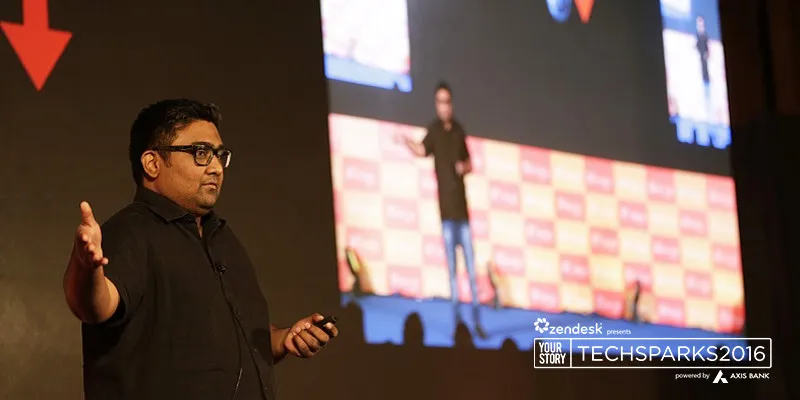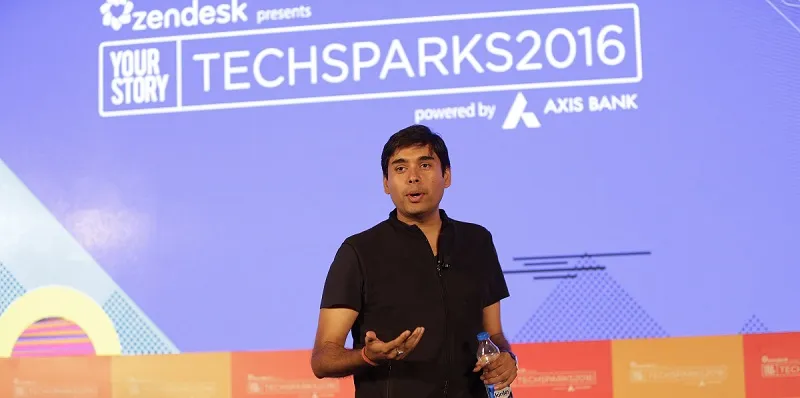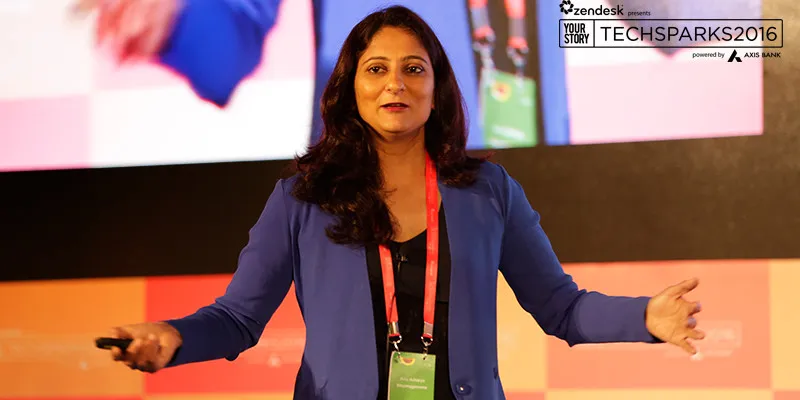5 new things we learnt at TechSparks that go beyond valuation and GMV
TechSparks, YourStory’s recently concluded flagship event, left the startup community shaken and stirred for all the right reasons.
With industry experts, entrepreneurs, and investors on stage and off it, there were some interesting concepts and theories that came to light:
The Delta 4 — Kunal Shah
While we talk about how to be more effective, Kunal Shah, Founder and Chairman of FreeCharge posed his million-dollar question about problem-solving and efficiency.
“Which goods and services were more efficient 10 years ago? That is a difficult question to find an answer to. This is because all efficiencies that have been created are for the future. And this is unique to human beings; we are hacking efficiency through different goods and services,” he said.

His ‘Delta 4’ theory talks about figuring out how to unlock that proverbial pot of gold.
Kunal shared, “All entrepreneurs have ideas, ideas that are building efficiencies in their own way. Many of us build things, and almost 99 percent of them fail. How does one know that one has moved away and created an efficiency that will unlock wealth? This is where Delta 4 comes in.”
According to Kunal, if you score the efficiency of the existing situation and the proposed solution on a scale of 1 to 10, the gap should be greater than 4.
He cited going to the railway ticketing counter and booking through IRCTC as a perfect example of how the comparative efficiency generated by the solution is greater than 4. Virtually no one who has ever experienced it once will go back to booking through a ticketing counter. “And every time you hit a Delta of 4, you’ve hit the perfect efficiency scale,” says Kunal.
Once a Delta 4 is created, you do not go back to the previous inefficient system. The other factors that work for Delta 4 include the USP (Unique Selling Proposition) vs UBP (Unique Brag Proposition) where, according to Kunal, “Everyone is trying to get you to move away from the inefficiency and those who have, brag about it to others who haven’t.” Also, there is a high tolerance where despite glitches, the user behaviour does not change. You might have faced problems with IRCTC, but that doesn’t mean you will not go back to the ticketing counter.
Hence, Delta 4 leads to wealth creation.
Stages of creativity — Ashwin Sanghi
One of India’s bestselling conspiracy fiction writers, Ashwin Sanghi spoke of what leads to creativity and also about its stages. According to him, the two stages that eventually result in creativity are unlearning and connectivity.
According to Ashwin, years of learning unfortunately give us a blinkered vision. To get rid of this blinkered vision, one has to go through a process of unlearning. The process of unlearning can lead to a process of connecting and creativity.

Using optical illusions, Ashwin pointed out that one can actually look at an image and hold on to two ideas. “Most people see one image and with some effort you can train your brain to see both. The ability to simultaneously entertain two seemingly opposite ideas is really the starting point of unlearning. You have to really change your mind to view the alternative as an equally legitimate outcome.”
The ability to create space; to play with ideas — even outrageous ones; to dare to believe the impossible is true; to accommodate multiple conflicting ideas simultaneously and move ahead even in the face of objections from experts leads to connections, which in turn lead to creativity. He cited the example of Hara and Hari: Ashwin explained how mythological characters are a creation of larger mythical processes. The universe is constantly expanding and contracting. He referred to the ever-expanding universe as Vishnu, and the continuously contracting, to it as Shiva (Hara). According to Ashwin, “This process of expansion and contraction creates the universe, or ‘Brahma’ as we know it. This can be applied to a lot of real-life activities.”
Ashwin spoke about how real-life incidents influenced his style of writing and how he connected the dots. This connection led to creativity.
“Believe in the power of the imagination; what you think is impossible today may well happen tomorrow. Don’t feel shy to have multiple ideas. Creativity is going beyond what is commonly explainable. Dare to dream different.”
T20 or Test cricket startup — Naveen Tewari
On a day that saw cricket’s big star MS Dhoni rule theatres, Naveen Tewari brought the game to the TechSparks stage. This one is for all the entrepreneurs and aspiring entrepreneurs who love cricket. His theory was that a startup’s journey in its early stage is like a T20 match — experiments can be conducted and new products can be introduced. Full of adrenaline, it draws viewership and attracts fans.

As a startup graduates from the early stage to the middle stage, the business becomes more serious. From T20, the company moves to a One-Day format where the pace decreases. The viewership exists, but the support is not as ecstatic. It has its thrills and spills. Players are expected to take on more responsibility, and to some extent are accountable for their actions. There is an expectation of utilising the resources at hand.
The last stage bears a similarity to cricket’s Test format. At this stage, things undergo a complete transformation — the rules are different and the pace changes. As players need to exercise caution, this phase can become boring at times. However, the truth is that the focus is on the fundamentals. It’s about positive EBITDA (earnings before interest, taxes, depreciation and amortisation) and sustainable growth.
These formats don’t come with clear definitions; unlike in cricket, each startup has to figure out the change in format on its own. Nobody tells you this. Each startup founder and management team has to realise what format of cricket it is playing.
“Ganga nahaye kya aur nichode kya” — Kishore Biyani
Kishore Biyani, the Founder and CEO of Future Group brought down the house with his witty remarks and shared some interesting data about e-commerce companies. “If you understand today’s e-commerce models, how can you fund them? In an e-commerce model, 20 percent is the customer acquisition, 20 percent is fulfilment cost, eight percent is technology cost, 48 percent is the cost of running the business plus the office and other costs. Which product will give you this little margin that you can make money on? It is like the saying Ganga nahaye kya, aur nichode kya” (not enough of something).

Given his experience in business, this is some food for thought.
The entrepreneurial gene — Anu Acharya
“Genetics doesn’t determine entrepreneurship, but it does push towards it,” says Anu Acharya, the expert on genome mapping. According to Anu, the CEO of MapMyGenome, some of the qualities that define entrepreneurs include the right coping mechanisms, impulsive streak to take quick decisions and work along ideas and problems, and the ability to garner attention. Believe it or not, genes can determine 47 percent of these traits.

The genes in themselves are not enough; what is needed is an environment that helps nurture these traits accompanied with inclination. Using her own example, Anu pointed out how her father encouraged his five children to go earn money and try new things. However, Anu was the only one who took to entrepreneurship.
The ideas these speakers touched upon showed that the startup ecosystem is not just about valuation and funding but about nurturing, efficiency, and creation. It is a journey that is about so much more than just revenue — it is about people, building value, and learning to move with the times and challenges.







